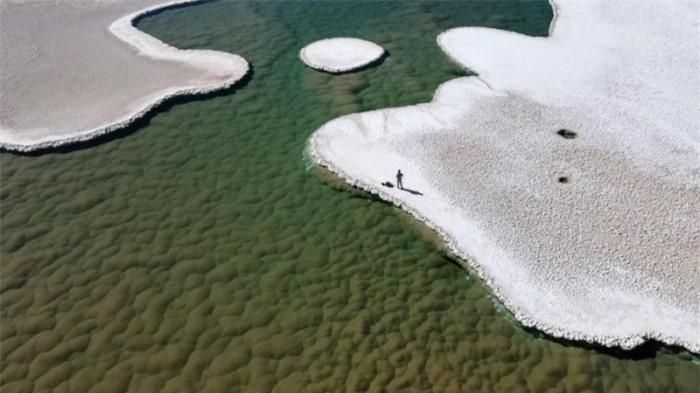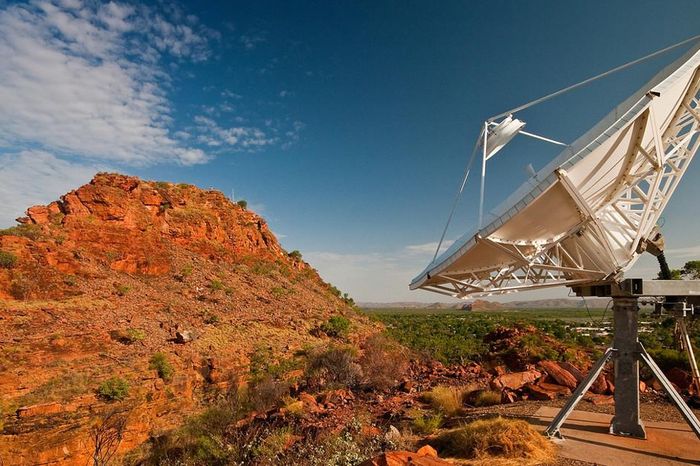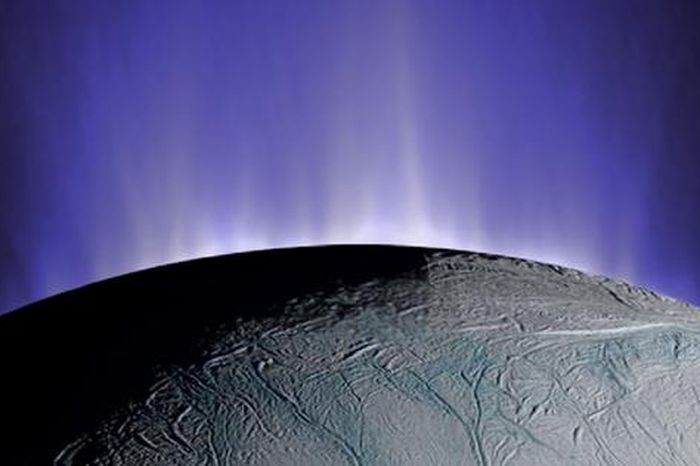The microbiome in desert lagoons may reflect early life on Mars
The crystal-clear lagoons and vast salt flats of the Puna de Atacama desert form an unusual ecosystem, researchers say, unlike anything they've ever seen.
Puna de Atacama is a large plateau located at an altitude of more than 3,660m above sea level, on the Argentine border with Chile. Here, the high altitude combined with dry conditions and bright sunlight combine to create a harsh environment where few animals or plants can survive.

Mounds of green stromatolites bloom at the bottom of the lagoon at Puna de Atacama, Argentina. Photo: Brian Hynek
This strange ecosystem was discovered through satellite images. It spans 10 hectares of desert and includes 12 shallow lagoons, surrounded by mountains. Under the surface of the lagoon, there are mounds about 4.6 meters wide, dozens of centimeters high and covered with green microorganisms.
According to researchers, these mounds reveal to us the early stages of life on Earth and possibly ancient life on Mars. Preliminary observations suggest these may be stromatolites – complex microbial communities whose secretions harden into layers of rock. Similar microbial communities were present during a period of Earth's history, the Archean, when the atmosphere did not have oxygen (4 billion to 2.5 billion years ago).
Today, stromatolites still form in marine and freshwater habitats, but in much smaller forms than ancient stromatolites. The mounds in Atacama Lagoon are similar in size to fossils found in Archean stromatolites, which were up to 6 meters tall. The Atacama stromatolites mainly contain gypsum, a mineral commonly found in fossil stromatolites but not present in present-day stromatolites.
The researchers used rock hammers to crack the stromatolite structure, revealing the pink core. Photo: Brian Hynek
Researchers think these mounds grew from microorganisms. The structures are submerged in the lagoon's acidic, salty water and are heated by high radiation from the sun. They contain two types of bacteria, with layers of photosynthetic bacteria called cyanobacteria covering the outside, and a community of single-celled organisms called archaea growing at the core.
According to researchers, if life evolved on Mars to the fossil level, it would look like this. Understanding existing microbial communities on Earth will help us know what to look for when probing similar features of rocks on Mars. However, scientists need to quickly confirm these initial observations, as the site has been leased for lithium mining and the entire ecosystem will likely be completely gone within a few years.
You should read it
- The strangest objects ever taken on Mars surprised many
- 5 most interesting findings about Red Planet
- Stunned to discover river fossils on Mars
- There are major changes in the atmosphere of Mars
- Find strong evidence of life on Mars
- Why are microorganisms living 'so tough' on Earth but still hard to survive on Mars
- The answer to the disappearance of water on Mars already exists
- Details of the plan to turn a successful Mars man for only $ 100,000 by Elon Musk
May be interested
- Looking back at NASA's Mars exploration process over the past 20 years
 the following article will help you have a better overview of the journey to explore mars since the first time nasa brought robots to mars, two decades ago.
the following article will help you have a better overview of the journey to explore mars since the first time nasa brought robots to mars, two decades ago. - The strangest objects ever taken on Mars surprised many
 scientists have captured many strange things on mars, from spoons, squirrels, blueberries to women ... but no one is sure whether they are real or not.
scientists have captured many strange things on mars, from spoons, squirrels, blueberries to women ... but no one is sure whether they are real or not. - 5 most interesting findings about Red Planet
 mars has always attracted the attention of scientists. people have sent a lot of probes to discover interesting things in this red planet. the findings below will certainly surprise you.
mars has always attracted the attention of scientists. people have sent a lot of probes to discover interesting things in this red planet. the findings below will certainly surprise you. - Found the world's oldest desert 30 million years
 desert in central asia is considered the oldest desert on our planet.
desert in central asia is considered the oldest desert on our planet. - Strange phenomenon: The second snow fell on the Sahara desert
 the sahara desert is probably too famous for its extreme climate, the hottest and largest desert in the world. moreover, it is certain that the sahara desert is the last place on this earth where we can think of snow. yet this christmas snow has fallen in the sahara desert.
the sahara desert is probably too famous for its extreme climate, the hottest and largest desert in the world. moreover, it is certain that the sahara desert is the last place on this earth where we can think of snow. yet this christmas snow has fallen in the sahara desert. - The new device can capture water from the arid desert atmosphere
 in field trials, a harvesting device drew water from the desert air in tempe, arizona. new technology can allow people to survive in some of the harshest regions on earth.
in field trials, a harvesting device drew water from the desert air in tempe, arizona. new technology can allow people to survive in some of the harshest regions on earth. - 'Mars Garden - Martian Gardens' helps scientists find ways to grow vegetables on Mars
 simulation of martian gardens helps nasa scientists learn about plants that astronauts can grow on red planet.
simulation of martian gardens helps nasa scientists learn about plants that astronauts can grow on red planet. - Organic matter on Mars was not created by life?
 newly published research shows that a large amount of organic matter on mars was not created by life, but by natural processes.
newly published research shows that a large amount of organic matter on mars was not created by life, but by natural processes. - These 15 tips will help you get up early in the morning very effectively
 get up early instead of sleeping and let your morning pass without doing anything.
get up early instead of sleeping and let your morning pass without doing anything. - Invite to receive blockbuster Black Desert Remastered $ 30, is free
 all gamers who pre-registered black desert mobile will be offered a free copy of the game black desert on pc, ps4, xbox for $ 29.99.
all gamers who pre-registered black desert mobile will be offered a free copy of the game black desert on pc, ps4, xbox for $ 29.99.










 Countries are stepping up efforts to search for extraterrestrial life
Countries are stepping up efforts to search for extraterrestrial life Traces of life in an unexpected place in the middle of the solar system
Traces of life in an unexpected place in the middle of the solar system One day on the Moon is equal to how many days on Earth?
One day on the Moon is equal to how many days on Earth? China successfully launched the first 6G satellite into space
China successfully launched the first 6G satellite into space Where does the moon originate?
Where does the moon originate? Hubble Telescope extremely rare photo of the moment of the Supernova explosion
Hubble Telescope extremely rare photo of the moment of the Supernova explosion